Peavey XR 800F User Manual
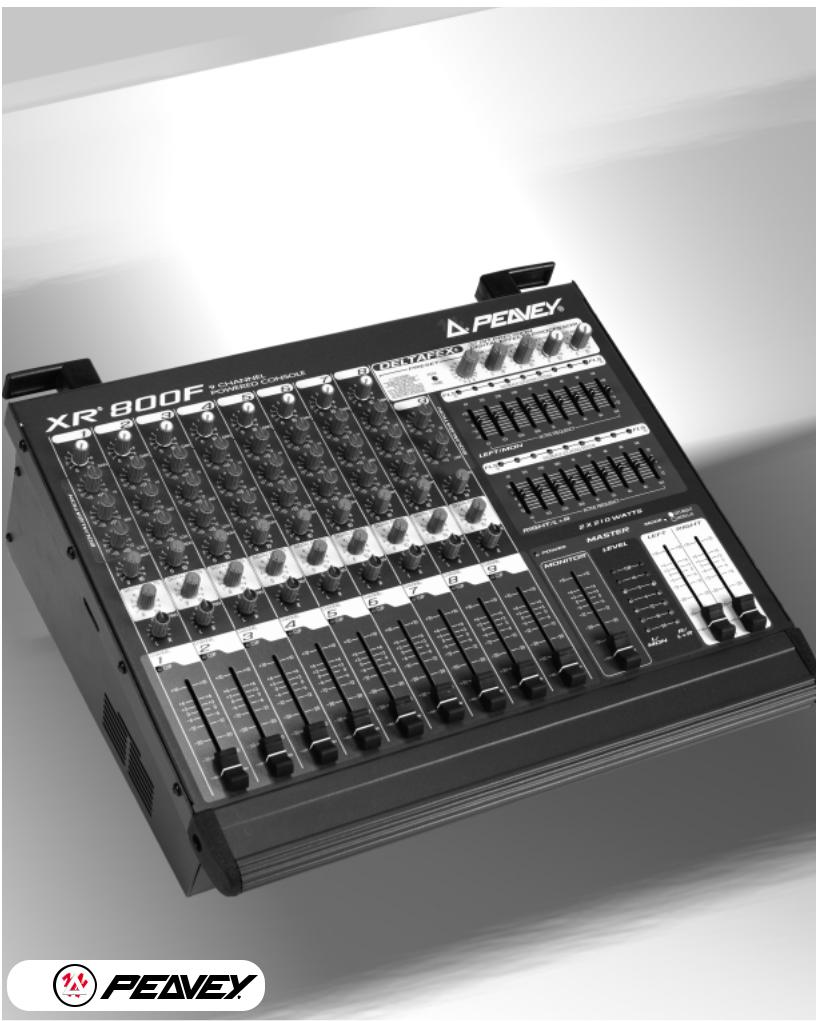
XR™ 800F
Channel Powered Console
Operating Guide
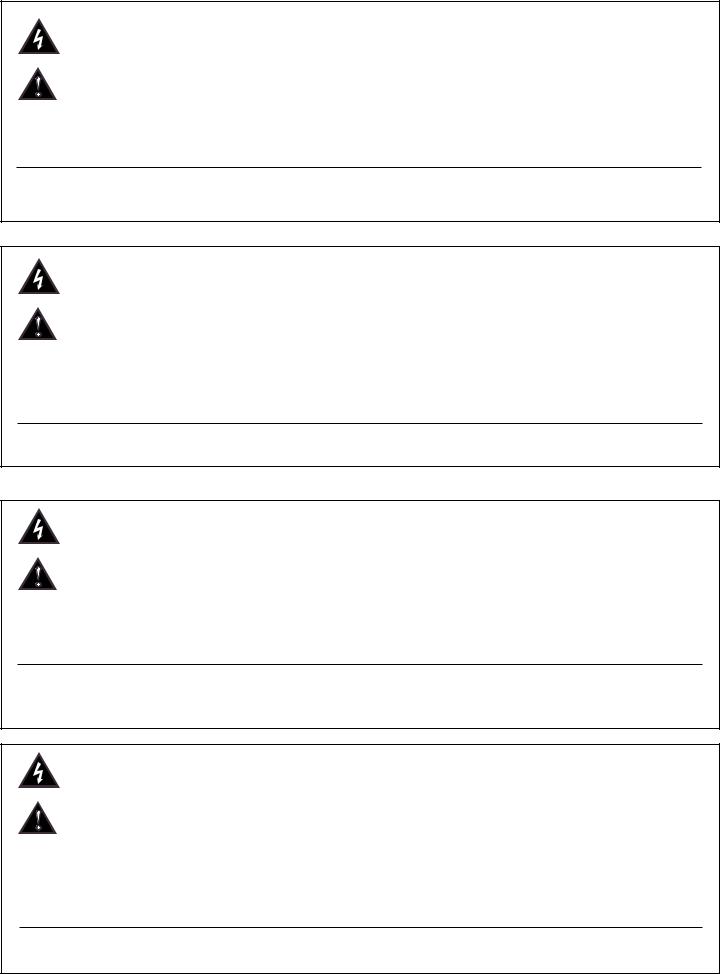
Intended to alert the user to the presence of uninsulated “dangerous voltage” within the product’s enclosure that may be of sufficient magnitude to constitute a risk of electric shock to persons.
Intended to alert the user of the presence of important operating and maintenance (servicing) instructions in the literature accompanying the product.
CAUTION: Risk of electrical shock — DO NOT OPEN!
CAUTION: To reduce the risk of electric shock, do not remove cover. No user serviceable parts inside. Refer servicing to qualified service personnel.
WARNING: To prevent electrical shock or fire hazard, do not expose this appliance to rain or moisture. Before using this appliance, read the operating guide for further warnings.
Este símbolo tiene el propósito, de alertar al usuario de la presencia de “(voltaje) peligroso” sin aislamiento dentro de la caja del producto y que puede tener una magnitud suficiente como para constituir riesgo de descarga eléctrica.
Este símbolo tiene el propósito de alertar al usario de la presencia de instruccones importantes sobre la operación y mantenimiento en la información que viene con el producto.
PRECAUCION: Riesgo de descarga eléctrica ¡NO ABRIR!
PRECAUCION: Para disminuír el riesgo de descarga eléctrica, no abra la cubierta. No hay piezas útiles dentro. Deje todo mantenimiento en manos del personal técnico cualificado.
ADVERTENCIA: Para evitar descargas eléctricas o peligro de incendio, no deje expuesto a la lluvia o humedad este aparato Antes de usar este aparato, Iea más advertencias en la guía de operación.
Ce symbole est utilisé dans ce manuel pour indiquer à l’utilisateur la présence d’une tension dangereuse pouvant être d’amplitude suffisante pour constituer un risque de choc électrique.
Ce symbole est utilisé dans ce manuel pour indiquer à l’utilisateur qu’il ou qu’elle trouvera d’importantes instructions concernant l’utilisation et l’entretien de l’appareil dans le paragraphe signalé.
ATTENTION: Risques de choc électrique — NE PAS OUVRIR!
ATTENTION: Afin de réduire le risque de choc électrique, ne pas enlever le couvercle. Il ne se trouve à l’intérieur aucune pièce pouvant être reparée par l’utilisateur. Confiez I’entretien et la réparation de l’appareil à un réparateur Peavey agréé.
AVERTISSEMENT: Afin de prévenir les risques de décharge électrique ou de feu, n’exposez pas cet appareil à la pluie ou à l’humidité. Avant d’utiliser cet appareil, lisez attentivement les avertissements supplémentaires de ce manuel.
Dieses Symbol soll den Anwender vor unisolierten gefährlichen Spannungen innerhalb des Gehäuses warnen, die von Ausreichender Stärke sind, um einen elektrischen Schlag verursachen zu können.
Dieses Symbol soll den Benutzer auf wichtige Instruktionen in der Bedienungsanleitung aufmerksam machen, die Handhabung und Wartung des Produkts betreffen.
VORSICHT: Risiko — Elektrischer Schlag! Nicht öffnen!
VORSICHT: Um das Risiko eines elektrischen Schlages zu vermeiden, nicht die Abdeckung enfernen. Es befinden sich keine Teile darin, die vom Anwender repariert werden könnten. Reparaturen nur von qualifiziertem Fachpersonal durchführen lassen.
ACHTUNG: Um einen elektrischen Schlag oder Feuergefahr zu vermeiden, sollte dieses Gerät nicht dem Regen oder Feuchtigkeit ausgesetzt werden. Vor Inbetriebnahme unbedingt die Bedienungsanleitung lesen.
2

ENGLISH
XR™ 800F Powered Sound Reinforcement Mixing Console
Congratulations on your purchase of the XR™ 800F powered mixer. Peavey has packed features from the popular XR 684 into a professional 9-channel, tabletop package. The newest member of the famous Peavey XR family, the XR 800F, represents years of powered mixer experience combined with the latest in technology and packaging. Here are several features you will find on the XR 800F.
•Eight low-noise, low-Z mic preamps (Channels 1-8)
•Six 1/4" line inputs (Channels 1-6)
•Three Stereo line inputs (Channels 7-9)
•60 mm channel and master faders
•Channel clipping LEDs
•Channel stereo pan controls
•Three-band equalization (Channels 1-8)
•Monitor send (each channel)
•EFX send (each channel)
•32-bit precision, DSP-based stereo effects processor with 16 presets and two parameter controls
•Two 9-band graphic EQs with FLS® Feedback Locating System®
•Selectable 48 V phantom power
•Dual seven segment master level meters
•Stereo/Main-monitor mode switch
•2x210 W @ 4 ohms internal power amplifier
•420 W @ 8 ohms in bridge mode
•DDT™ speaker protection
The standard channels (1-6) feature discrete low noise mic preamps with globally switched phantom power, line level 1/4" inputs, and three-band EQs. Finally, there are three stereo channels (7-9) for tape, CD, or synth inputs. Channels 7 and 8 reflect Channels 1 through 6 with added stereo 1/4" input jacks. Channel 9, however, has a two-band EQ, no input gain control, and only stereo tape input and output jacks.
The master section features a unique graphic equalizer/power amp mode switch. Without patching, the XR 800F can be used as a full stereo mixer amplifier (default). In the Main/Monitor mode, one graphic and amplifier can be used for monitor and the other graphic and amplifier for the main L and R (mono) signal.
Also included in the master section are 16 stereo digital effects from the award winning Deltafex™ digital signal processor. By including separate time/size and color/tone controls, the user can create many effect settings from the 16 we provided. All channels, including Channel 9, have a dedicated digital effects send routed directly to the DSP effects processor.
To take advantage of the XR 800F’s powerful features, please read this owner’s manual carefully and keep it as a reference. This manual includes several sections detailing individual areas of mixer operation, including: control functions, setup, and applications in sound reinforcement. Before the channel and master functions are explained, we will begin with connecting AC power and speakers to the XR 800F.
3
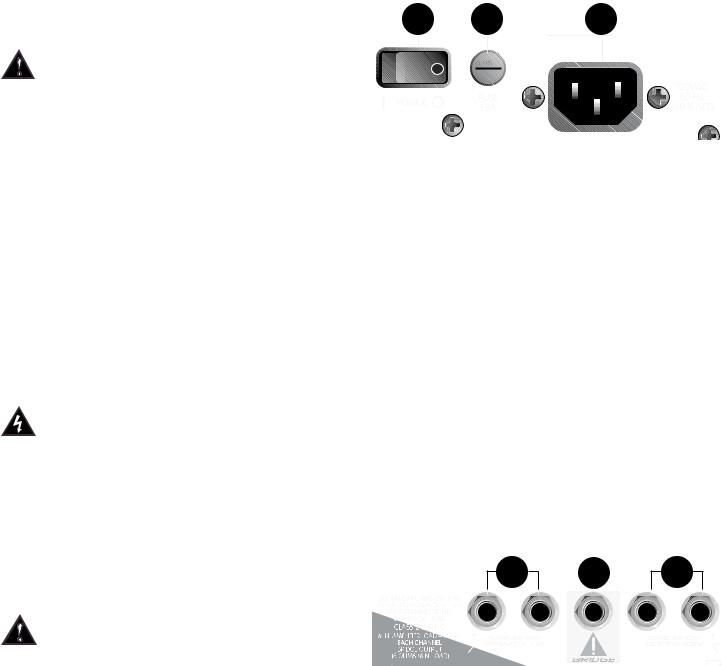
AC POWER SECTION
The AC POWER SECTION explains the proper connections/method to supply AC power to your XR 800F. Please pay close attention to the precaution(s) noted below in order to ensure both personal and equipment safety.
1. |
A/C POWER INLET: |
2 |
3 |
1 |
|
This receptacle is for the IEC line cord |
|
|
|
|
(included), which provides AC power to the |
|
|
|
|
unit. Connect the line cord to this connector |
|
|
|
|
and to a properly grounded AC supply. |
|
|
|
|
Damage to the equipment may occur if an |
|
|
|
|
improper line voltage is used. (See voltage |
|
|
|
|
marking on unit.) Never remove or cut the ground pin of the line cord plug. This unit is |
|||
|
supplied with a properly rated line cord. When lost or damaged, replace this cord with one of |
|||
|
the proper ratings. |
|
|
|
2.POWER:
This is the mixer’s main power switch. The Power LED indicator (21) will illuminate when the unit is powered.
3.FUSE:
This is the main safety fuse for the AC line voltage. Only replace the fuse with one of the exact same type and rating. IF THE FUSE CONTINUES TO OPEN, DO NOT REPLACE WITH A LARGER FUSE. TAKE THE UNIT TO AN AUTHORIZED PEAVEY SERVICE CENTER!
WARNING: THE FUSE SHOULD ONLY BE REPLACED WHEN THE POWER CORD HAS BEEN DISCONNECTED FROM ITS POWER SOURCE.
POWER AMPLIFIER SECTION
The POWER AMPLIFIER SECTION will explain the proper method of connecting your XR 800F to your speakers. This is a very versatile area of the XR 800F. However, it is important that
you follow the precautions to insure safe operating impedances and avoid improper connections.
4. PARALLEL LEFT/RIGHT SPEAKER OUTPUTS: |
4 |
5 |
4 |
|
These 1/4" jacks are the outputs for the two |
||||
|
|
|
||
internal amplifiers. You will notice that there |
|
|
|
|
are two pairs of jacks with another jack in |
|
|
|
|
the middle. The two pairs are the two (L/R) |
|
|
|
|
amp outputs. Two cabinets can be connected to |
|
|
|
each amplifier, as long as the combined impedance of the cabinets is not less than 4 ohms. (i.e., two 8 ohms cabinets in parallel = 4 ohms, four 16 ohms speakers in parallel = 4 ohms, etc.) Do not use the Bridge Output (5) while using these outputs. The outputs from these jacks are determined by the System Mode Switch (20).
5. BRIDGE OUTPUT:
The bridge output of the XR 800F allows the power of the left and right amplifiers to be combined into one mono output in applications where only one speaker will be used. To use the bridge output, the system mode switch must be in the Left/Right position. Connect an 8 ohm minimum impedance speaker to the center bridge output jack.
4
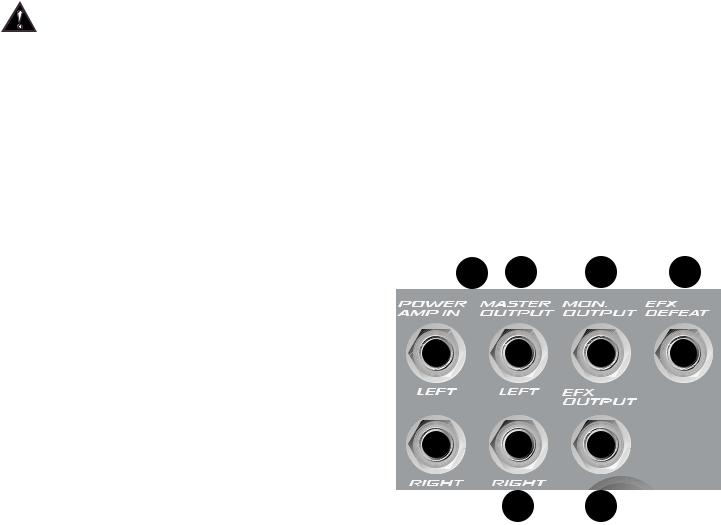
CAUTION: When the bridge outputs are being used, no other speakers should be connected to the adjacent parallel speaker outputs. In addition, the minimum load for the XR 800F in
bridge mode is 8 ohms. Do not allow the total impedance to drop below 8 ohms or serious damage to the amplifier may occur.
MASTER IN/OUT
The MASTER IN/OUT section describes the functions related to the input and output patch panel located on the rear of your XR 800F. This section is often overlooked but adds the most versatility to the XR 800F. When used to its fullest potential, an extraordinary variety of wiring configurations can be made. These connections allow for devices such as outboard effects, power amps, monitors, and virtually any other type of line level audio device to be patched in to the XR 800F. Some of these configurations are displayed in the hookup diagram found at the end of this manual.
6.POWER AMP INPUTS:
Plugging into these jacks allows the user to go |
6 |
|
7 |
|
9 |
|
11 |
||||||||||
directly into the Graphic Equalizers (L and R), |
|
|
|
|
|
|
|
|
|
|
|
|
|
|
|
|
|
|
|
|
|
|
|
|
|
|
|
|
|
|
|
|
|
|
|
then into its respective power amplifier channel. |
|
|
|
|
|
|
|
|
|
|
|
|
|
|
|
|
|
The jacks for these inputs are switching jacks. |
|
|
|
|
|
|
|
|
|
|
|
|
|
|
|
|
|
|
|
|
|
|
|
|
|
|
|
|
|
|
|
|
|
||
This means that if you plug into the jack you |
|
|
|
|
|
|
|
|
|
|
|
|
|
|
|
|
|
|
|
|
|
|
|
|
|
|
|
|
|
|
|
|
|
||
will defeat any prior signal from the channel, |
|
|
|
|
|
|
|
|
|
|
|
|
|
|
|
|
|
master and effects sections of the amp. A |
|
|
|
|
|
|
|
|
|
|
|
|
|
|
|
|
|
|
|
|
|
|
|
|
|
|
|
|
|
|
|
|
|
||
benefit of this feature is that you can then use |
|
|
|
|
|
|
|
|
|
|
|
|
|
|
|
|
|
|
|
|
|
|
|
|
|
|
|
|
|
|
|
|
|
||
the internal stereo EQ and power amp with or |
|
|
|
|
|
|
|
|
|
|
|
|
|
|
|
|
|
without using the channel and effects sections. |
|
|
|
|
|
|
|
|
|
|
|
|
|
|
|
|
|
|
|
|
|
|
|
|
|
|
|
|
|
|
|
|
|
||
Essentially, you can use the XR 800F as a |
|
|
|
|
|
|
|
|
|
|
|
|
|
|
|
|
|
slave stereo EQ/power amp when needed. |
|
|
|
|
|
|
|
|
|
|
|
|
|
|
|
|
|
|
|
|
|
|
|
|
|
|
|
|
|
|
|
|
|
||
810
7.LEFT OUTPUT:
This 1/4" jack provides an output from the Left Main mix to supply external amp/speaker combinations. The level of this signal is determined by the Left Master Fader.
8.RIGHT OUTPUT:
This 1/4" jack provides an output from the Right Main mix to supply external amp/speaker combinations. The level of this signal is determined by the Right Master Fader.
9.MONITOR OUTPUT:
This 1/4" jack provides an output from the monitor mix to supply external power amp/monitor combinations. The level of this signal is determined by the Monitor Master Fader.
10.EFX OUTPUT:
This 1/4" jack provides an output of the effects mix. (The same signal that goes to the internal effects processor.) This signal can be used with external effects units or as an additional (post fader) monitor output.
11.EFX DEFEAT: This 1/4" (Tip/Sleeve) jack provides a means to defeat the internal effects of the XR 800F. A standard on/off footswitch, such as the Peavey part number 5100, is recommended.
5

MASTER FUNCTIONS
The MASTER FUNCTIONS section describes those features that are considered master controls. Essentially, this makes up all of the functions on the right-hand, front panel side of your XR 800F. The areas of detail include; Effects, EQ/FLS and Monitor/Master Level Controls.
12 |
13 |
14 |
15 |
16 |
17 |
12.EFFECTS PEAK LED:
Illuminates to indicate -6 dB of headroom before the signals being sent to the effects circuit are clipped. Ideally, you would want this LED to light only occasionally if at all. An occasional blink indicates that you have the levels at an optimum setting. It is advisable to listen carefully to the output at the same time in order to determine the final setting. If you hear distortion then one or more of the input digital effects level controls are set too high.
13.PRESET: Selects the effect preset from the list below.
EFX Presets
PRESET |
NAME |
TIME/SIZE |
1 |
Chamber |
Time: 150 to 5,000 ms |
2 |
Plate |
Time: 100 to 4,000 ms |
3 |
Room |
Time: 150 to 5,000 ms |
4 |
Cathedral |
Time: 100 to 8,000 ms |
5 |
Spring |
Time: 150 to 5,000 ms |
6 |
Gate |
Time: 150 to 500 ms |
7 |
Reverse |
Time: 150 to 500 ms |
8 |
Delay + Reverb |
Time: 0 to 225 ms |
9 |
Bright Delay |
Time: 0 to 500 ms |
10 |
Warm Delay |
Time: 0 to 500 ms |
11 |
Dark Delay |
Time: 0 to 500 ms |
12 |
Ping Pong Delay |
Time: 0 to 500 ms |
13 |
Chorus |
Rate: 0.125 to 8 Hz |
14 |
Phaser |
Rate: 0.250 to 16 Hz |
15 |
Flange |
Rate: 0.10 to 2.5 Hz |
16 |
Rotary Speaker |
High Speed: 0.50 to 25 Hz |
COLOR/TONE
Damping (High Frequency) Damping (High Frequency) Damping (High Frequency) Damping (High Frequency) Damping (High Frequency) Damping (High Frequency) Damping (High Frequency) Reverb Time: 0 to 5,000 ms Feedback: 0 to 99% Feedback: 0 to 99% Feedback: 0 to 99% Feedback: 0 to 99% Depth: Best Set Full CW Depth: Best Set Full CW Depth: Best Set Full CW Width: 0 to 100% CW
14.TIME/SIZE:
In Reverb and Delay presets (presets 1-12), this control adjusts the time of the particular reverb or delay; in Chorus, Phaser, and Flange, it adjusts the rate of each. In Rotary Speaker setting, this adjusts the speed of the speaker rotation.
15.COLOR/TONE:
Adjusts the high frequency content of the effects signal. (While using a delay, this control adjusts the feedback or depth.)
16.EFX to MON:
Controls the amount of effects signal sent to the monitor mix. This control allows effects to be heard from the stage via the monitor.
17.EFX to MAIN: Controls the amount of effects signal sent to the main mix.
6

18
19 |
18.FLS (Feedback Locator System):
These LEDs illuminate to indicate the frequency band of highest energy. When feedback occurs, this system will automatically indicate the graphics slider to use to lessen or eliminate feedback. (NOTE: These LEDs illuminate with any audio signal, not just during feedback.) If feedback occurs, pull down the slider under the brightest LED.
19.GRAPHIC EQUALIZERS:
These nine-band equalizers are fixed on one-octave centers. They are designed for 12 dB of cut and 12 dB boost. They are connected directly to their power amplifier inputs. The signal sent to each equalizer is determined by the System Mode Switch (20).
20.SYSTEM MODE SWITCH:
This switch is used to configure the XR 800F as either a stereo or dual mono amplifier. It is recessed to prevent accidental switching during a performance. Use a non-metallic object to change the switch position (e.g., a toothpick). The XR 800F is shipped from the factory in the default setting of Left Main to the upper EQ and Right to the lower EQ. When this switch is depressed it switches the lower EQ to (mono) PA Left + Right. The upper EQ then becomes the Monitor signal only, creating an entire PA and Monitor mixing system in one small, easy- to-carry package. And this change is accomplished without a single patch cord!
21 |
23 |
20 |
21. |
POWER LED: |
|
|
|
|
The power on LED indicator will light when the |
|
|
|
|
unit is powered. |
|
|
|
22. |
MONITOR MASTER FADER: Sets the overall level |
|
|
|
|
of the monitor signal that is sent to the Monitor |
|
|
|
|
Output (9) jack. See page 5. |
|
|
|
23. |
SIGNAL LEVEL METERS: Displays overall level of |
|
|
|
|
either the L and R signals or the Mon and L+R (mix) |
|
|
|
|
signals. The System Mode Switch determines which |
|
|
|
|
mode the meter will operate in. Red Clip LEDs are |
|
|
|
|
located at the top of each meter to indicate clipping. |
|
22 |
24 |
|
A clipped signal may damaged your speakers. |
|
|
To prevent possible speaker damage reduce the |
||
|
|
|
|
respective fader level.
7
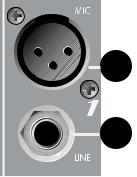
24.MASTER L/R FADERS:
This is the master level control for the L and R signals sent to the Left and Right Output jacks. When in Main/Monitor mode [see System Mode Switch (20)] the Monitor Fader controls the monitor signal present at the Left/Mon Power Amp Output (4). The Left and Right Faders would then control the L/R Mix present at the Right/L+R Power Amp Output (4). The nominal position for this control is the 0 dB position.
CHANNEL FUNCTIONS
The CHANNEL FUNCTIONS section describes the controls and input connections for each channel of the XR 800F. Most features are found on all channels, however, there are some differences in channel’s 7, 8 and 9. Therefore, this section is divided to properly indicate those differences.
CHANNELS 1-6
25. |
MIC INPUT: |
|
|
XLR balanced, low impedance channel input optimized for a microphone |
|
|
or other low-level source. Pin 2 is the positive input. Because of the wide |
|
25 |
range of gain adjustment, signal levels as high as +10 dBV (2.45 V RMS) |
|
can be accommodated. When the phantom power is enabled, this |
||
|
||
|
connector has +48 V on Pins 2 (in phase) and 3 with Pin 1 as the ground |
|
|
reference. |
|
26 |
|
|
26. |
LINE INPUT: |
1/4" balanced TRS line level input. The tip is the positive (in phase) input, which can also be used for unbalanced inputs. This signal is connected
through a 20 dB pad to the mic input below it. Within the same channel, the Mic Input and the Line Input cannot be used simultaneously. Channels 7 and 8 feature stereo versions of the Line Input. (See features 36 and 37 page 10.)
8

27
28
29
30
31
32
33
34
35
27.GAIN:
Varies the input gain to each channel. Proper adjustment of the input gain will maximize the signal to noise ratio giving you the quietest operation. With your Channel Fader (35) set to the “0” position, set this control so that the Clip LED (34) barely lights at the highest peaks in your input signal.
28.HIGH EQ:
A shelving type of active tone control that varies the treble frequency levels ±15 dB at 12 kHz. It is designed to remove noise or to add brilliance to the signal, depending on the quality of the source. (The high control can also be found on Channels 7 through 9.)
29.MID EQ:
Mid ±15 dB. This control sets the amount of cut or boost at the mid-frequency (850 Hz). The mid control can also be found on Channels 7 and 8.
30.LOW EQ:
A shelving type of active tone control that varies the bass frequency levels ±15 dB at 70 Hz. It will add depth to thin signals, or clean up muddy ones. (The low control can also be found on Channels 7 through 9.)
31.MON:
Adjusts the level of the channel signal (pre-EQ) that is added to the Monitor mix. (The Monitor control can also be found on Channels 7 through 9.) This control is independent of the Channel Fader control (35).
32.DIGITAL EFFECTS:
This control varies the level into the digital effects processor bus by adjusting the signal level from the particular channel to the digital processor. The channel Gain (27) control also affects this level. The digital effects send is after the channel fader and is therefore affected by the channel fader setting.
33.PAN:
Sets the channel’s position in the L/R stereo field. In the stereo Channels (7, 8 and 9) this control acts as a balance control between the two separate inputs.
34.CLIP LED:
Indicates when the signal input is too strong and signal clipping is present. A clipped signal may damage your speakers.
35.CHANNEL FADER:
Sets the signal level sent to the Left and Right bus. (This feature can also be found on Channels 7 through 9.)
9
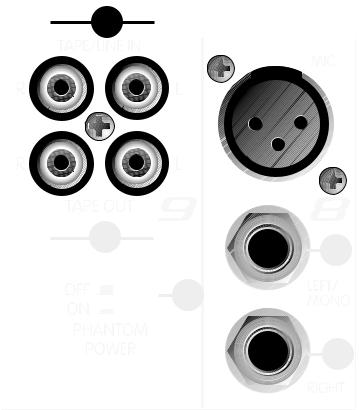
CHANNELS 7 - 8
NOTE: Channels 7 - 8 contain features that differ from the previous channels. Only those features are mentioned below.
|
|
|
|
38 |
|
|
36. |
RIGHT INPUT: |
|||||
|
|
|
|
||||||||||
|
|
|
|
|
|
|
|||||||
|
|
|
|
|
|||||||||
|
|
|
|
|
|
||||||||
|
|
|
|
|
|
|
|
|
|
|
|
|
1/4" input for line level signals. The |
|
|
|
|
|
|
|
|
|
|
|
|
|
Right Input is not adjusted by the Gain |
|
|
|
|
|
|
|
|
|
|
|
|
|
(27) control. The signal is then routed |
|
|
|
|
|
|
|
|
|
|
|
|
|
to the internal power amp. If the |
|
|
|
|
|
|
|
|
|
|
|
|
|
XR 800F is in Left/Right mode then |
|
|
|
|
|
|
|
|
|
|
|
|
|
the signal will go to the Right Speaker |
|
|
|
|
|
|
|
|
|
|
|
|
|
Output (4). In Mon/Main mode the |
|
|
|
|
|
|
|
|
|
|
|
|
|
signal is combined with the Left and |
|
|
39 |
|
|
|
|
|
|
37 |
|
placed on the Right/L+R Speaker |
||
|
|
|
|
|
|
|
|
||||||
|
|
|
|
|
|
|
Output. The right signal can also be |
||||||
|
|
|
|
|
|
|
|
|
|
|
|
|
|
|
|
|
|
|
|
|
|
|
|
|
|
|
patched out of the XR 800F via the |
|
|
|
|
|
|
|
|
40 |
|
|
|
|
Right Output jack (8) to external |
|
|
|
|
|
|
|
|
|
|
|
|||
|
|
|
|
|
|
|
|
|
|
|
|
|
components such as effects, power |
|
|
|
|
|
|
|
|
|
|
|
|
|
|
|
|
|
|
|
|
|
|
|
|
|
|
|
amps, and recording devices. This |
|
|
|
|
|
|
36 |
|
feature is only found on Channels 7 |
|||||
|
|
|
|
|
|
|
|
|
|
|
|
|
and 8. |
37. LEFT/MONO INPUT:
1/4" input for line level signals. The Left/Mono input supplies signal to both the Left and Right channels (if there is nothing inserted to the right input jack). It is not adjusted by the Gain Control (27). In Left/Right mode the signal will go to the Left Speaker Output (4) and Right Speaker Output if nothing is inserted to the right input jack. In Mon/Main mode the signal is combined with the Right and placed on the Right/L+R Speaker Output. This feature is only found on Channels 7 and 8.
CHANNEL 9
NOTE: Channel 9 contains features that differ from the previous channels. Only those features are mentioned below.
38.TAPE IN:
This stereo RCA phono jack accepts a stereo input (nominally -10 dBV) from the output of a tape deck or CD player and places it on the Left and Right channels as well as the Monitor and Effects Mix. See feature 31 on page 9.
39.TAPE OUT:
This stereo RCA phono jack provides a signal for the recording inputs of a stereo tape deck.
CAUTION! DO NOT HOOK THE TAPE IN AND TAPE OUT TO THE INPUT AND OUTPUT OF THE SAME DECK AT THE SAME TIME. DOING SO WILL FORM A LOOP CAUSING SEVERE FEEDBACK. USE SEPARATE DECKS FOR RECORDING AND PLAYBACK, OR USE THE INPUTS AND OUTPUTS OF THE SAME DECK AT SEPARATE TIMES.
10

PHANTOM POWER
40.PHANTOM POWER SWITCH:
Applies 48 V DC voltage to all input XLR connectors to power microphones that require it.
CAUTION! When phantom power is switched on, make sure that any channel you are plugging a mic into is turned down in both the main and monitor mixes. Otherwise, there will be a loud pop in the PA. This is normal. It is best to plug all mics into their respective channels with the phantom power switched off. This reduces noise in the PA and reduces the chances of the mic being damaged. If phantom power is used, do not connect unbalanced microphones or other devices that cannot handle this voltage to the XLR inputs. (Some wireless receivers may be damaged; consult their manuals for compatibility.) The line input 1/4" jacks are not connected to the phantom supply, and are safe for all inputs (balanced or unbalanced). An unbalanced-to-balanced impedance converter, such as the Peavey 5116 or a Peavey 1:1 Interface Adapter, can also be used to isolate a mic from phantom voltage.
11
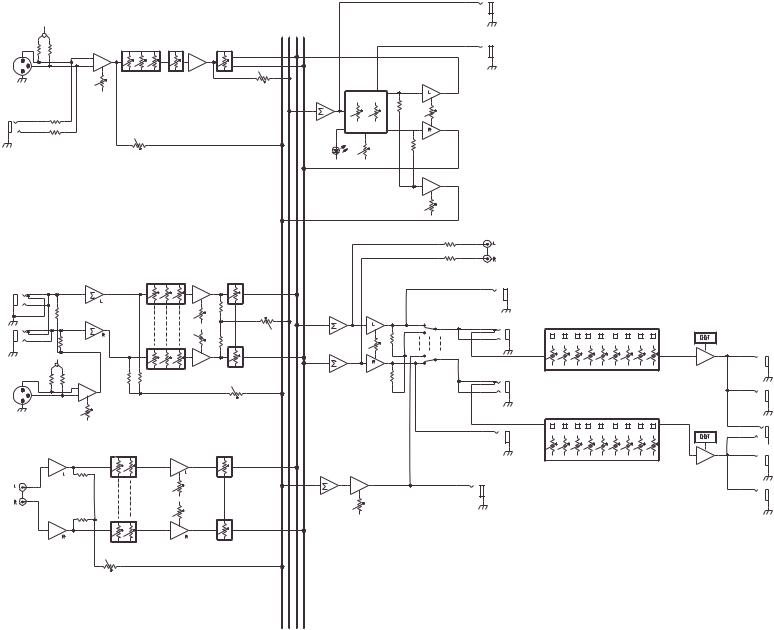
12
XR 800F BLOCK DIAGRAM
CHANNELS 1-6 |
|
BUSMON BUSEFF BUSLEFT |
BUSRIGHT |
|
|
|
EFFECTS OUT |
||
+48V PHANTOM |
|
|
|
|
|
Tone Control |
|
|
|
|
LO MID HI |
|
|
EFFECTS DEFEAT |
LEVEL |
PAN |
|
LO-Z INPUT |
EFX LEVEL |
|
|
|
|
Pre Gain |
DIGTAL EFFECTS |
|
LINE INPUT |
|
EFFECTS TO MAIN |
|
TIME |
COLOR |
|
PEAK |
EFFECTS |
|
LED |
|
20 dB Pad |
SELECTOR |
|
Monitor |
|
EFFECTS TO |
|
MONITOR |
|
TAPE OUT |
CHANNELS 7-8 |
Tone Control |
|
|
|
STEREO LINE INPUT |
LO MID HI |
PAN/BALANCE |
LEFT MAIN OUTPUT |
|
|
|
|||
L/MONO |
|
|
|
MODE SELECT |
|
|
|
|
|
|
|
LEVEL |
LEFT POWER AMP INPUT |
|
|
|
|
EFX LEVEL |
|
RIGHT |
|
|
|
|
+48 PHANTOM |
|
|
|
|
LO-Z INPUT |
MIC PREAMP |
LO MID HI |
PAN/BALANCE |
RIGHT POWER AMP INPUT |
|
|
|
||
|
|
|
MONTOR |
|
|
MIC GAIN |
|
|
|
CHANNELS 9 (TAPE) |
Tone Control |
|
|
|
LO HI |
BALANCE |
|
||
|
|
|
|
RIGHT MAIN OUTPUT |
TAPE/CD |
|
|
|
|
INPUT |
|
|
|
MONTOR OUTPUT |
|
|
LEVEL |
|
MONTOR |
|
|
|
|
MASTER |
LO HI |
BALANCE |
|
|
MONTOR |
|
LEFT/ L-R
63 125 250 500 1K 2K 4K 8K 16K
|
|
LEFT/ MON |
9 BAND EQUALIZER WITH FLS |
POWER AMP |
POWER AMP OUT |
|
|
RIGHT MON
63 125 250 500 1K 2K 4K 8K 16K
BRIDGE OUT
9 BAND EQUALIZER WITH FLS
POWER AMP
RIGHT/L+R
POWER AMP OUT
210 WATTS PER CHANNEL• 4 OHMS
150 WATTS PER CHANNEL• 8 OHMS BRIDGE 420 WATTS • 8 OHMS
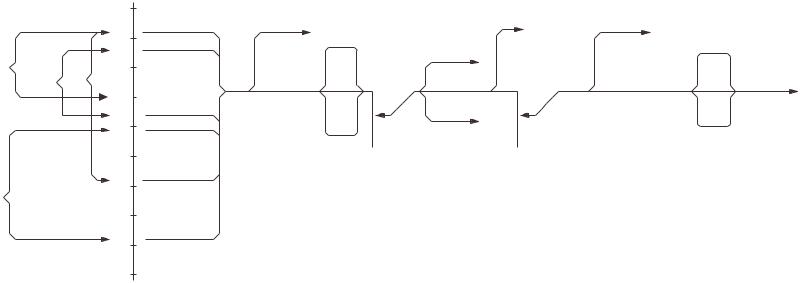
XR 800F LEVEL DIAGRAM
13
INPUTS
+30
+20
STEREO |
LINE |
+10 |
|
LINE |
|||
|
|||
TAPE |
|
||
|
0dBu |
||
|
|
||
|
|
-20 |
|
|
|
-20 |
|
LO-Z MIC |
|
-30 |
|
|
|
-40 |
|
|
|
-50 |
|
|
|
-60 |
+21 dBu
+16 dBu
+5 dBu
+11 dBu
-29 dBu
-48 dBu
MONITOR OUT |
|
|
LEFT & RIGHT OUT |
|
+21 dBu MAX. |
|
MONITOR OUT |
|
|
|
+21 dBu MAX |
|
||
CHANNEL EQ |
TAPE OUT |
+21 dBV MAX |
GRAPHIC |
|
EQ |
|
|||
+15 dB |
-10 dBV MAX |
|
|
|
|
+12 dB |
|
||
|
|
|
TO POWER AMPS |
|
2 dBu-0 dBV |
|
|
|
|
|
|
|
+2 dBu NOMINAL |
|
|
-10 dBV MON |
-12 dB |
|
|
|
|
L/R FADER |
|
|
-15 dB CHANNEL |
|
|
||
FADER |
|
|
|
|
0 dB GAIN |
10 dB GAIN |
|

Recording Deck





 L
L In
In  R
R
XR 800F HOOK-UP DIAGRAM
MIDI Sound Module
|
|
L |
Out |
R |
|
CD Player |
|
|
|
L |
Out |
R |
|
|
|
|
|
Firebass 700
Line Out
PVM™ 22
SP™2G SP™2G
SP™112M SP™112M
*Shown with system mode switch depressed
14

XR 800F
Specifications:
Input Specifications:
Function |
|
Input Z |
Input Gains |
|
Input Levels |
|
Bal/ |
Connector |
|
|
|
(ohms) |
|
Min** |
|
Nominal* |
Max |
UnBal. |
|
|
|
Min |
|
|
|
|
|
|
|
|
|
|
|
|
|
|
|
|
|
Low-Z Mic |
|
2.2 k |
Max (48 dB) |
-68 dBu |
|
-48 dBu |
-27 dBu |
Bal. |
XLR: Pin 1 Gnd, |
(150 ohms) |
|
|
Min (10 dB) |
|
|
|
|
|
Pin 2 (+), |
|
|
|
|
|
|
|
|
|
Pin 3 (-) |
|
|
|
|
-30 dBu |
|
-10 dBu |
+11 dBu |
|
|
|
|
|
|
|
|
|
|
|
|
Line Input |
|
22 k |
Max |
-49 dBu |
|
-29 dBu |
-8 dBu |
Unbal. |
1/4" TRS: Tip (+), |
Channels 1-6 |
|
|
(29 dB) |
|
|
|
|
|
Ring (-), |
|
|
|
|
|
|
|
|
|
Sleeve Ground |
|
|
|
Min |
-11 dBu |
|
+10 dBu |
+31 dBu |
|
|
|
|
|
(-10 dB) |
|
|
|
|
|
|
|
|
|
|
|
|
|
|
|
|
Stereo Line |
|
22 k |
Max Gain |
-20 dBu |
|
0 dBu |
+21 dBu |
Unbal. |
1/4" Phono Tip (+), |
Inputs Chs. 7-8 |
|
|
(20) dB) |
|
|
|
|
|
Sleeve Ground |
|
|
|
|
|
|
|
|
|
|
Tape |
|
20 k |
Max. Gain |
-26 dBu |
|
-6 dBu |
+16 dBu |
Unbal. |
RCA Jacks |
|
|
|
(26 dB) |
|
|
|
|
|
|
0 dBVu=0.775 V (RMS) |
|
|
|
|
|
|
|
|
|
**Min input level (sensitivity) is the smallest signal that will produce nominal output (2 dBu) with channel and master level controls set for maximum gain.
*Nominal settings are defined as all controls set a 0 dB (or 50% rotation for rotary pots).
XR 800F Output Specifications:
Function |
Minimum Load Z |
Output Level |
Bal./Unbal. |
Connector |
|
|
(ohms) |
|
|
|
|
|
|
Nominal |
Max |
|
|
|
|
|
|
|
|
Main L/R |
600 |
+2 dBu |
+21 dbu |
Unbal. |
1/4" Phono Tip (+), |
|
|
|
|
|
Sleeve Ground |
Monitor |
600 |
+2 dBu |
+21 dBu |
Unbal. |
1/4" Phono Tip (+), |
|
|
|
|
|
Sleeve Ground |
|
|
|
|
|
|
Effects |
600 |
+2 dBu |
+21 dBu |
Unbal. |
1/4" Phono Tip (+), |
|
|
|
|
|
Sleeve Ground |
|
|
|
|
|
|
Tape |
10 k |
-10 dBu |
+10 dBu |
Unbal. |
RCA |
|
|
|
|
|
|
|
|
|
|
|
|
+2 dBu = 0 dBV = 1V (RMS)
Gain:
Mic Input Adjustment Range:
Mic Input to L and R Output
Mic Input longest path
Mic Input Adjustment Range: Line Input to L and R Output Mic Input longest path
10 dB to 48 dB
68 dB (Max Gain)
96 dB (Max Gain) power amp out
-10 dB to 28 dB 49 dB (Max Gain)
77 dB (Max Gain) power amp out
15
